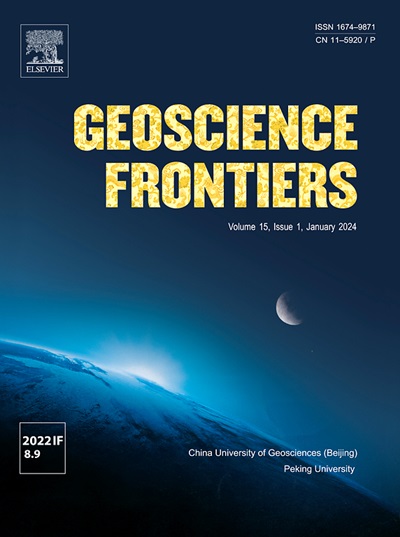Seasonal effects on groundwater fluoride and evaluating health hazards: In-situ remediation via managed aquifer recharge
IF 8.9
1区 地球科学
Q1 GEOSCIENCES, MULTIDISCIPLINARY
引用次数: 0
Abstract
This research examines the hard-rock aquifer system within the Nagavathi River Basin (NRB) South India, by evaluating seasonal fluctuations in groundwater composition during the pre-monsoon (PRM) and post-monsoon (POM) periods. Seasonal variations significantly influence the groundwater quality, particularly fluoride (F−) concentrations, which can fluctuate due to changes in recharge, evaporation, and anthropogenic activities. This study assesses the dynamics of F− levels in PRM and POM seasons, and identifies elevated health risks using USEPA guidelines and Monte Carlo Simulations (MCS). Groundwater in the study area exhibits alkaline pH, with NaCl and Ca-Na-HCO3 facies increasing in the POM season due to intensified ion exchange and rock-water interactions, as indicated in Piper and Gibb’s diagrams. Correlation and dendrogram analyses indicate that F− contamination is from geogenic and anthropogenic sources. F− levels exceed the WHO limit (1.5 mg/L) in 51 PRM and 28 POM samples, affecting 371.74 km2 and 203.05 km2, respectively. Geochemical processes, including mineral weathering, cation exchange, evaporation, and dilution, are identified through CAI I & II. Health risk assessments reveal that HQ values >1 in 78% of children, 73% of teens, and 68% of adults during PRM, decreasing to 45%, 40%, and 38%, respectively, in POM. MCS show maximum HQ values of 5.67 (PRM) and 4.73 (POM) in children, with all age groups facing significant risks from fluoride ingestion. Managed Aquifer Recharge (MAR) is recommended in this study to minimize F− contamination, ensuring safe drinking water for the community.

地下水氟化物的季节性影响和健康危害评价:通过管理含水层补给进行原位修复
本研究通过评估季风前(PRM)和季风后(POM)时期地下水组成的季节性波动,考察了南印度纳加瓦蒂河流域(NRB)内的硬岩含水层系统。季节变化显著影响地下水质量,特别是氟化物(F -)浓度,其可因补给、蒸发和人为活动的变化而波动。本研究评估了PRM和POM季节F−水平的动态变化,并使用USEPA指南和蒙特卡罗模拟(MCS)确定了健康风险升高。研究区地下水呈碱性,由于离子交换和岩水相互作用加剧,在POM季节,NaCl和Ca-Na-HCO3相增加,如Piper和Gibb的图所示。相关分析和树状图分析表明,氟污染既有地质来源,也有人为来源。51个PRM和28个POM样品的F−含量超过WHO限值(1.5 mg/L),分别影响371.74 km2和203.05 km2。地球化学过程包括矿物风化、阳离子交换、蒸发和稀释等。2。健康风险评估显示,在PRM期间,78%的儿童、73%的青少年和68%的成年人的HQ值为>;1,在POM期间分别降至45%、40%和38%。MCS显示儿童的最大HQ值为5.67 (PRM)和4.73 (POM),所有年龄组都面临氟摄入的重大风险。本研究建议采用含水层管理补给(MAR),以尽量减少F -污染,确保社区饮用水安全。
本文章由计算机程序翻译,如有差异,请以英文原文为准。
求助全文
约1分钟内获得全文
求助全文
来源期刊

Geoscience frontiers
Earth and Planetary Sciences-General Earth and Planetary Sciences
CiteScore
17.80
自引率
3.40%
发文量
147
审稿时长
35 days
期刊介绍:
Geoscience Frontiers (GSF) is the Journal of China University of Geosciences (Beijing) and Peking University. It publishes peer-reviewed research articles and reviews in interdisciplinary fields of Earth and Planetary Sciences. GSF covers various research areas including petrology and geochemistry, lithospheric architecture and mantle dynamics, global tectonics, economic geology and fuel exploration, geophysics, stratigraphy and paleontology, environmental and engineering geology, astrogeology, and the nexus of resources-energy-emissions-climate under Sustainable Development Goals. The journal aims to bridge innovative, provocative, and challenging concepts and models in these fields, providing insights on correlations and evolution.
 求助内容:
求助内容: 应助结果提醒方式:
应助结果提醒方式:


